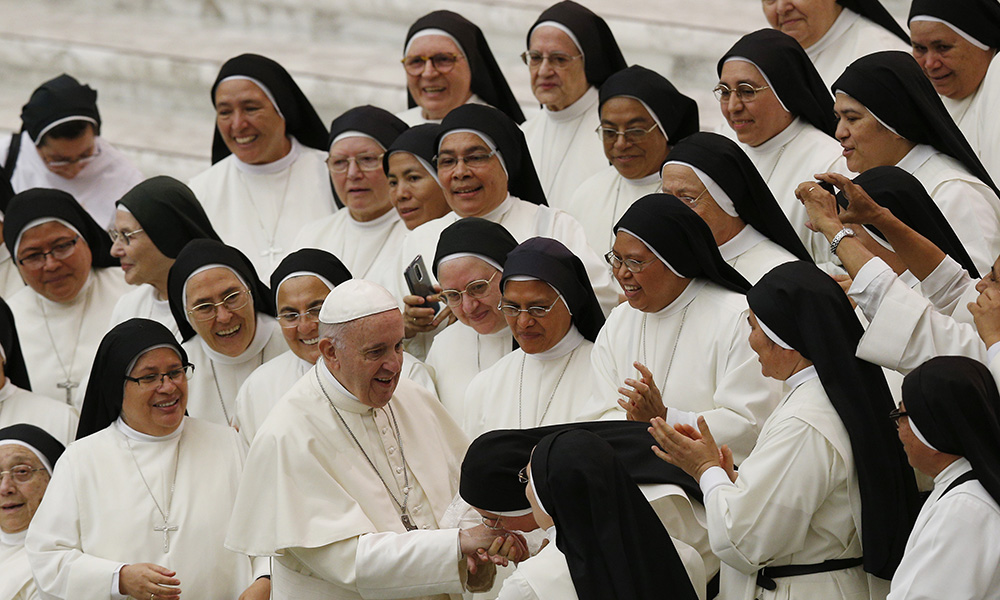For 99 percent of Catholics out there, there is no difference in their mind between a nun and a sister, nor between an order and a congregation. But in view of the law of the Church — canon law — there are differences, but I will limit myself to only a broad description of the differences.
According to canon law, there are Institutes of Consecrated Life and Societies of Apostolic Life today, commonly known as orders or congregations.
The main difference between an Institute of Consecrated Life and a Society of Apostolic Life is members of the first must take religious vows, whereas members of a Society of Apostolic Life may take religious vows.
While an Institute of Consecrated Life or a Society of Apostolic Life might refer to itself as an order or a congregation, such as the Benedictine order or the Congregation of the Sacred Heart, canon law does not use that terminology.
Both nuns and sisters are women religious and constitute a most beautiful way of serving Jesus Christ and all souls in the Church. A nun takes solemn and public perpetual vows of chastity, poverty and obedience (evangelical counsels), and typically spends her life in prayer and work and silence in a cloistered convent. This is the contemplative life.
A nun will renounce all ownership of property so she can devote herself entirely to the service of God. A nun also wears a habit. Discalced Carmelites, Poor Clares and Passionists are just a few of these orders.
When you think of a nun, think of St. Thérèse of Lisieux, a great saint who spent her life in prayer in the Carmel Convent of Lisieux.
A sister takes simple perpetual vows of chastity, poverty and obedience (evangelical counsels), and may or may not live in community, and lives an active life typically serving in health care or educational institutions. Sisters renounce all ownership to property except inheritances and trusts. They may retain ownership of those assets but are not allowed to use the income from those assets.
Sisters may or may not wear habits, according to the rules of their community and the spirit of their founder. When you think of a sister, think of St. Elizabeth Ann Seton who founded the Congregation of the Sisters of Charity of St. Joseph and worked tirelessly as the founder of Catholic education in this country.
So far so good. But it can get confusing, because while a nun is not a sister, both are addressed as sister. And while this analogy may not be perfect, a nun is more like “Mary” while a sister is more like “Martha.”
Both fulfill essential tasks in the Church, but the first is focused on the contemplative life of prayer, while the other is dedicated to the active life of work sustained by prayer. Without prayer, no one can persevere in a good work.
A religious order (religious institute) is composed of either men or women, living in community but apart from the world. The Code of Canon Law specifies:
“The life consecrated through the profession of the evangelical counsels is a stable form of living by which the faithful, following Christ more closely under the action of the Holy Spirit, are totally dedicated to God who is loved most of all, so that, having been dedicated by a new and special title to His honor, to the building up of the Church, and to the salvation of the world, they strive for the perfection of charity in the service of the kingdom of God and, having been made an outstanding sign in the Church, foretell the heavenly glory.
“The Christian faithful freely assume this form of living in institutes of consecrated life canonically erected by competent authority of the Church. Through vows or other sacred bonds according to the proper laws of the institutes, they profess the evangelical counsels of chastity, poverty, and obedience and, through the charity to which the counsels lead, are joined in a special way to the Church and its mystery” (Canon 573).
They follow the charism and spirit of their founder. Orders can be contemplative or active. The oldest order is that of St. Benedict, but other well-known orders are the Carthusians, Cistercians, Carmelites, Franciscans and Norbertines.
Their main task is to pray and adore God in contemplation and offer the prayer of the Church (Divine Liturgy) in community to the glory and honor of God. Men and women members of religious orders wear the habit particular to their order.
A religious congregation is also composed of either men or women, but usually in the active life of service to the Church in education, health care or other corporal or spiritual works of mercy.
Typically they will wear a habit if they are a sister, but men of religious congregations — if they are priests — typically dress the same as other secular or diocesan priests of the country where they reside.
In general terms, religious “orders” — Benedictines (sixth century), Franciscans (12th century), Dominicans (13th century), Carmelites (12th century) — came first, and later came the religious congregations and Societies of Apostolic Life.
In all cases, nuns and sisters, orders and congregations, are manifestations of the charisms of the Holy Spirit to enrich the people of God.
Rev. Francis Hoffman, J.C.D., Executive Director of Relevant Radio. Follow him on his Facebook page “Father Rocky.”

